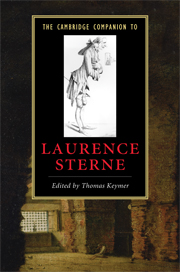Book contents
- Frontmatter
- Introduction
- 1 Laurence Sterne’s life, milieu, and literary career
- 2 Scriblerian satire, A Political Romance, the ‘Rabelaisian Fragment’, and the origins of Tristram Shandy
- 3 Tristram Shandy, learned wit, and Enlightenment knowledge
- 4 Tristram Shandy and eighteenth-century narrative
- 5 The Sermons of Mr. Yorick: the commonplace and the rhetoric of the heart
- 6 A Sentimental Journey and the failure of feeling
- 7 Sterne’s ‘politicks’, Ireland, and evil speaking
- 8 Words, sex, and gender in Sterne’s novels
- 9 Sterne and print culture
- 10 Sterne and visual culture
- 11 Sterne and the Modernist Moment
- 12 Postcolonial Sterne
- Further reading
- Index
- Series List
10 - Sterne and visual culture
Published online by Cambridge University Press: 28 January 2010
- Frontmatter
- Introduction
- 1 Laurence Sterne’s life, milieu, and literary career
- 2 Scriblerian satire, A Political Romance, the ‘Rabelaisian Fragment’, and the origins of Tristram Shandy
- 3 Tristram Shandy, learned wit, and Enlightenment knowledge
- 4 Tristram Shandy and eighteenth-century narrative
- 5 The Sermons of Mr. Yorick: the commonplace and the rhetoric of the heart
- 6 A Sentimental Journey and the failure of feeling
- 7 Sterne’s ‘politicks’, Ireland, and evil speaking
- 8 Words, sex, and gender in Sterne’s novels
- 9 Sterne and print culture
- 10 Sterne and visual culture
- 11 Sterne and the Modernist Moment
- 12 Postcolonial Sterne
- Further reading
- Index
- Series List
Summary
We will never know his name, and can only guess at his motives. He was probably a sailor, who possessed a copy of W.W. Ryland's stipple engraving (1779) after Angelica Kauffman's painting of 'Maria - Moulines', and had time on his hands. He cut out Maria's face, coloured it in, stitched it on an oval piece of canvas, and skilfully embroidered the rest with wool and silk: her white dress, her dog Sylvio, a brook, and a poplar tree (see Fig. 4). His 'woolwork' is unusual in that it does not depict a ship or naval scene, as is normally the case in this curious genre (woolwork being a type of woven or embroidered picture widely produced by sailors in the period, usually of their own vessels). And although this is a rare and early example, it is not the only one. At least one similar woolwork has recently been auctioned on the eBay website, and has an intriguing series of three finely-wrought silk embroidered pictures with cutwork appliqués, which tell the entire story that inspired them, from Maria sitting by the roadside in A Sentimental Journey to Yorick discovering her there and escorting her into Moulines. Sterne would have been pleased to find his 'Work of Redemption' (Letters 399) so popular in this humble species of folk art. He would also have been intrigued by the art form, and by the way in which his deliberate set-piece of sentimental writing had been translated into a visual medium, for he had a vivid interest in the relationship between word and image. From the very start of his writing career, he was aware of the self-promoting value of graphic representation in the business of marketing his work.
- Type
- Chapter
- Information
- The Cambridge Companion to Laurence Sterne , pp. 142 - 159Publisher: Cambridge University PressPrint publication year: 2009



